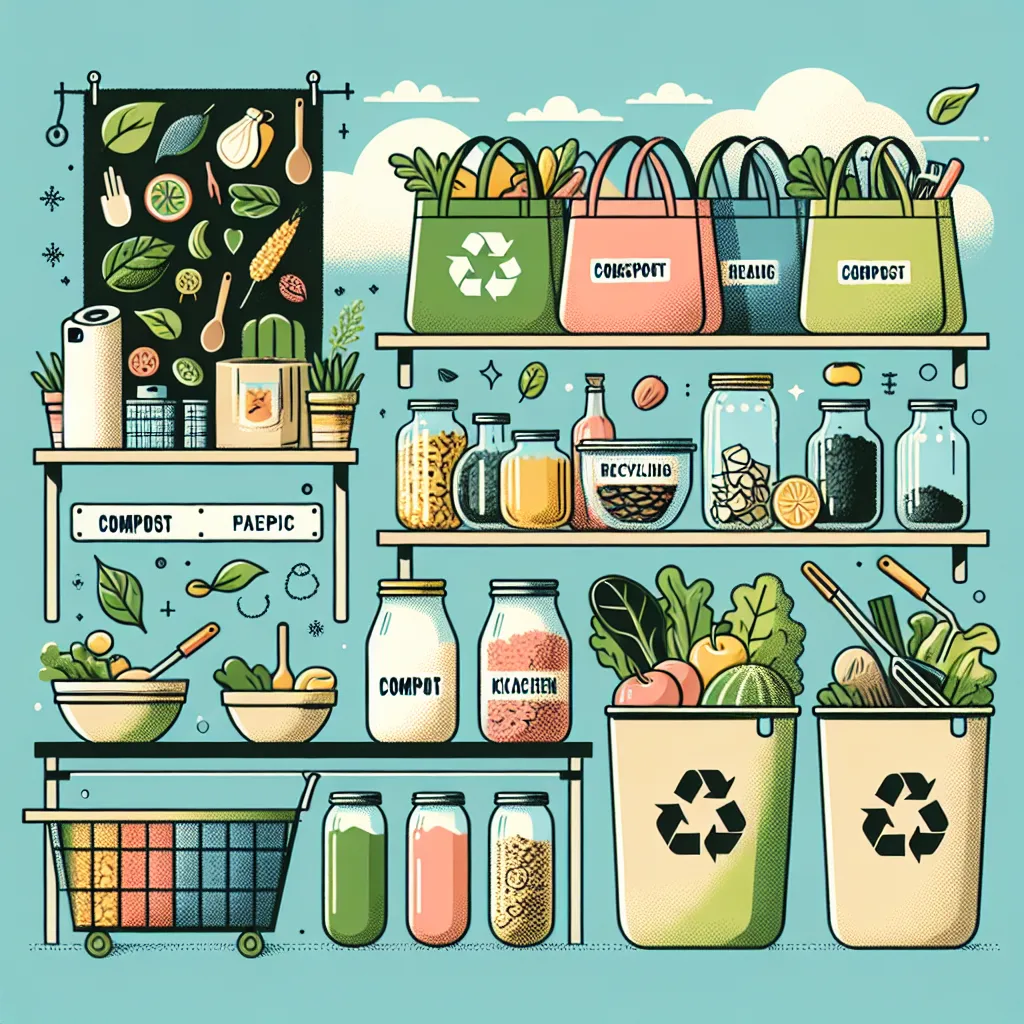Welcome to our IELTS Reading practice test focused on “The rise of zero-waste living.” This test is designed to help you prepare for the IELTS exam while exploring an important environmental topic. As an experienced IELTS instructor, I’ve crafted this practice test to closely mimic the actual IELTS Reading exam, providing you with valuable insights and strategies to excel in your upcoming test.
 Zero-waste living concept
Zero-waste living concept
IELTS Reading Practice Test: The Rise of Zero-Waste Living
Passage 1 – Easy Text
The Zero-Waste Movement: A Global Trend
The zero-waste movement has gained significant momentum in recent years, as more people become aware of the environmental impact of their daily habits. This lifestyle philosophy aims to reduce, reuse, and recycle as much as possible, with the ultimate goal of sending nothing to landfills. The concept of zero-waste living is not new, but its recent resurgence can be attributed to growing concerns about climate change, plastic pollution, and the depletion of natural resources.
Many individuals and communities around the world are embracing zero-waste principles in their everyday lives. This includes shopping at bulk stores with reusable containers, composting organic waste, and choosing products with minimal or no packaging. Some cities have even implemented zero-waste policies, encouraging residents and businesses to reduce their waste output dramatically.
The rise of social media has played a crucial role in spreading awareness about zero-waste living. Influencers and bloggers share tips, recipes, and DIY solutions for reducing waste, inspiring millions of followers to make small changes in their daily routines. From homemade cleaning products to upcycled furniture, the zero-waste community is constantly innovating to find sustainable alternatives to common household items.
While the zero-waste lifestyle may seem daunting at first, many practitioners argue that it leads to a simpler, more mindful way of living. By focusing on quality over quantity and prioritizing experiences over material possessions, zero-waste advocates often report feeling more satisfied and less stressed. Additionally, reducing waste can lead to significant cost savings over time, as individuals learn to make the most of what they have and avoid unnecessary purchases.
As the movement continues to grow, businesses are taking notice and adapting their practices to meet consumer demand for more sustainable options. From package-free stores to biodegradable products, the market for zero-waste solutions is expanding rapidly. This shift in consumer behavior and business practices has the potential to create lasting positive change for the environment and future generations.
Questions 1-7
Do the following statements agree with the information given in the reading passage?
Write:
TRUE if the statement agrees with the information
FALSE if the statement contradicts the information
NOT GIVEN if there is no information on this
- The zero-waste movement is a completely new concept.
- Zero-waste living aims to minimize the amount of waste sent to landfills.
- Some cities have implemented policies to promote zero-waste practices.
- Social media has had no impact on the spread of zero-waste ideas.
- Zero-waste living always leads to immediate cost savings.
- Many zero-waste advocates report feeling less stressed.
- All businesses are required to offer zero-waste options to consumers.
Questions 8-13
Complete the sentences below.
Choose NO MORE THAN TWO WORDS from the passage for each answer.
- The zero-waste movement has gained ___ in recent years due to environmental concerns.
- People practicing zero-waste living often shop at ___ stores using reusable containers.
- Social media ___ share tips and DIY solutions for reducing waste.
- Some zero-waste enthusiasts create ___ furniture as a sustainable alternative.
- Initially, adopting a zero-waste lifestyle may seem ___ to many people.
- The market for ___ products is growing rapidly in response to consumer demand.
Passage 2 – Medium Text
Implementing Zero-Waste Strategies in Urban Environments
Urban areas face unique challenges when it comes to waste management, making the implementation of zero-waste strategies particularly crucial in cities. With high population densities and limited space, traditional waste disposal methods are becoming increasingly unsustainable. As a result, many urban centers are turning to innovative zero-waste solutions to address these pressing issues.
One of the primary obstacles in urban zero-waste initiatives is the complexity of waste streams. Unlike rural areas, cities generate a diverse range of waste types, including household, commercial, industrial, and construction waste. This heterogeneity necessitates a multifaceted approach to waste reduction and management. Many cities are adopting comprehensive waste sorting programs, often utilizing advanced technologies such as optical sorting machines and artificial intelligence to improve recycling efficiency.
Another key strategy in urban zero-waste efforts is the promotion of the circular economy. This economic model aims to eliminate waste and maximize resource efficiency by keeping materials in use for as long as possible. In practice, this involves designing products for longevity and repairability, establishing repair cafes and tool libraries, and creating platforms for sharing and reusing goods. Some cities have even implemented “material banks” where construction materials from demolished buildings are cataloged and made available for reuse in new projects.
Urban farming and community gardens play a significant role in reducing organic waste while promoting food security and community engagement. These initiatives not only provide fresh, local produce but also serve as hubs for composting programs. Many cities are installing large-scale composting facilities to process organic waste from households and businesses, producing nutrient-rich soil for urban agriculture and landscaping projects.
The transition to zero-waste in urban areas also requires addressing the issue of packaging waste. Some cities have implemented strict regulations on single-use plastics and excessive packaging, encouraging businesses to adopt more sustainable practices. Package-free stores and refill stations for household products are becoming increasingly common in urban centers, offering residents alternatives to traditional packaged goods.
Education and community involvement are crucial components of successful urban zero-waste strategies. Many cities organize workshops, seminars, and public awareness campaigns to inform residents about proper waste sorting, composting techniques, and the importance of reducing consumption. Some municipalities have even introduced gamification elements to waste reduction, creating apps that reward citizens for their eco-friendly behaviors.
While the path to achieving zero-waste in urban environments is challenging, many cities are making significant progress. By combining technological innovations, policy changes, and community engagement, urban areas are demonstrating that a zero-waste future is not only possible but essential for creating sustainable, livable cities for generations to come.
Questions 14-19
Choose the correct letter, A, B, C, or D.
-
According to the passage, why is implementing zero-waste strategies particularly important in urban areas?
A) Urban areas produce more waste than rural areas
B) Cities have more resources to implement zero-waste strategies
C) Traditional waste disposal methods are becoming unsustainable in cities
D) Urban residents are more environmentally conscious -
What is described as a primary challenge for urban zero-waste initiatives?
A) Lack of funding
B) Resistance from residents
C) Limited technology
D) Complexity of waste streams -
How are some cities improving recycling efficiency?
A) By increasing the number of recycling bins
B) Through education programs
C) Using advanced technologies like AI
D) By outsourcing recycling to private companies -
What is the main goal of the circular economy model mentioned in the passage?
A) To increase profits for businesses
B) To eliminate waste and maximize resource efficiency
C) To create more jobs in the recycling industry
D) To reduce the cost of waste management for cities -
How do urban farming and community gardens contribute to zero-waste efforts?
A) By providing employment opportunities
B) Through reducing transportation emissions
C) By serving as hubs for composting programs
D) Through increasing property values -
What role does education play in urban zero-waste strategies?
A) It is not considered important
B) It focuses only on children in schools
C) It is crucial for informing residents about proper waste management
D) It is only necessary for businesses, not individuals
Questions 20-26
Complete the summary below.
Choose NO MORE THAN TWO WORDS from the passage for each answer.
Urban areas face unique challenges in waste management due to high population densities and limited space. To address these issues, many cities are implementing zero-waste strategies. One major obstacle is the (20) of urban waste streams, which requires a multifaceted approach to waste reduction. Cities are adopting comprehensive waste sorting programs and using advanced technologies to improve (21) .
The promotion of the (22) is another key strategy, which aims to keep materials in use for as long as possible. This involves designing products for longevity and establishing facilities like repair cafes. Some cities have created (23) to catalog and reuse construction materials.
Urban farming and community gardens contribute to reducing (24) ___ while promoting food security. Many cities are also installing large-scale composting facilities to process organic waste.
To address packaging waste, some cities have implemented regulations on (25) and excessive packaging. Education and community involvement are crucial, with cities organizing workshops and campaigns to inform residents about proper waste management. Some municipalities have even introduced (26) elements to encourage eco-friendly behaviors.
Passage 3 – Hard Text
The Psychological and Societal Implications of Zero-Waste Living
The zero-waste movement, while primarily focused on environmental sustainability, has far-reaching implications that extend into the realms of psychology and sociology. As individuals and communities increasingly adopt zero-waste practices, researchers are observing significant shifts in consumer behavior, social norms, and personal well-being. These changes not only reflect a growing environmental consciousness but also highlight the complex interplay between individual choices and broader societal structures.
One of the most notable psychological aspects of zero-waste living is its impact on consumer decision-making processes. The paradigm shift from a consumption-driven mindset to one of conscious reduction challenges deeply ingrained habits and societal expectations. This transition often requires individuals to critically examine their needs versus wants, leading to a reevaluation of personal values and priorities. Studies have shown that this process of introspection and mindful consumption can lead to increased life satisfaction and reduced anxiety related to material possessions.
However, the journey towards a zero-waste lifestyle is not without its psychological challenges. The concept of “eco-anxiety” – a chronic fear of environmental doom – has gained recognition in recent years, particularly among individuals who are highly engaged in environmental causes. While zero-waste practices can provide a sense of agency and control in the face of global environmental challenges, they can also lead to feelings of guilt or inadequacy when individuals perceive their efforts as insufficient. Psychologists emphasize the importance of balancing personal responsibility with realistic expectations to maintain mental well-being in the pursuit of sustainability.
From a sociological perspective, the zero-waste movement represents a significant shift in collective behavior and social norms. As more individuals adopt zero-waste practices, these behaviors begin to permeate social networks, creating new standards of acceptability and desirability. This phenomenon, known as social proof, can accelerate the adoption of sustainable practices within communities. However, it also raises questions about social inclusion and accessibility, as zero-waste options may not be equally available or feasible for all socioeconomic groups.
The zero-waste movement has also sparked discussions about the role of individual action versus systemic change in addressing environmental issues. While personal choices can significantly reduce one’s environmental impact, critics argue that focusing solely on individual responsibility may divert attention from the need for large-scale policy changes and corporate accountability. This tension highlights the complex relationship between personal ethics, collective action, and institutional structures in driving societal transformation.
Interestingly, the principles of zero-waste living have begun to influence areas beyond environmental sustainability. The concept of “zero-waste thinking” is being applied to fields such as time management, digital decluttering, and even interpersonal relationships. This holistic approach to resource efficiency reflects a broader cultural shift towards simplicity, intentionality, and mindfulness in various aspects of life.
The zero-waste movement has also led to the emergence of new social identities and communities. Online forums, local meetups, and zero-waste challenges have created spaces for individuals to share knowledge, support one another, and collectively reimagine social practices. These communities not only provide practical support but also foster a sense of belonging and shared purpose, which can be particularly valuable in navigating the challenges of lifestyle changes.
As the zero-waste movement continues to evolve, its psychological and societal impacts are likely to become increasingly pronounced. The interplay between individual choices, social norms, and systemic structures will continue to shape the trajectory of this movement, potentially leading to more fundamental shifts in how societies approach consumption, waste, and environmental stewardship. Understanding these complex dynamics will be crucial for policymakers, businesses, and individuals alike as we collectively work towards a more sustainable future.
Questions 27-32
Choose the correct letter, A, B, C, or D.
-
According to the passage, what is one of the most significant psychological aspects of zero-waste living?
A) Increased stress levels
B) A shift in consumer decision-making processes
C) Reduced environmental awareness
D) Higher levels of materialism -
What does the term “eco-anxiety” refer to?
A) Fear of adopting new environmental practices
B) Anxiety about the financial costs of going zero-waste
C) Chronic fear of environmental doom
D) Stress caused by peer pressure to be more eco-friendly -
How does the zero-waste movement impact social norms according to the passage?
A) It has no effect on social norms
B) It creates new standards of acceptability and desirability
C) It only affects a small, isolated group of people
D) It leads to increased social conflict -
What concern does the passage raise about the focus on individual action in the zero-waste movement?
A) It may distract from the need for systemic change
B) It is not effective in reducing waste
C) It puts too much pressure on corporations
D) It is too difficult for most people to adopt -
How is the concept of “zero-waste thinking” being applied beyond environmental sustainability?
A) Only in financial management
B) It is not being applied to other areas
C) In various aspects of life, including time management and relationships
D) Exclusively in digital technology -
What role do zero-waste communities play according to the passage?
A) They only provide practical tips for reducing waste
B) They create social division
C) They foster a sense of belonging and shared purpose
D) They focus solely on environmental policy advocacy
Questions 33-40
Complete the summary below.
Choose NO MORE THAN TWO WORDS from the passage for each answer.
The zero-waste movement has significant psychological and societal implications. It requires a (33) in consumer mindset, leading to a reevaluation of personal values. While this can increase life satisfaction, it may also contribute to (34) , a fear of environmental doom.
Sociologically, the movement represents a shift in (35) and social norms. The concept of (36) can accelerate the adoption of sustainable practices within communities. However, this raises questions about social inclusion and accessibility.
The movement has sparked debates about individual action versus (37) ___ in addressing environmental issues. The principles of zero-waste living are being applied to various areas of life, reflecting a cultural shift towards simplicity and mindfulness.
New social identities and communities have emerged, providing spaces for knowledge sharing and support. These communities foster a sense of (38) ___ and shared purpose.
As the movement evolves, its impacts on psychology and society are likely to become more pronounced. The interplay between individual choices, social norms, and (39) will shape its trajectory. Understanding these dynamics will be crucial for various stakeholders working towards a (40) future.
Answer Key
Passage 1
- FALSE
- TRUE
- TRUE
- FALSE
- NOT GIVEN
- TRUE
- FALSE
- momentum
- bulk
- influencers
- upcycled
- daunting
- biodegradable
Passage 2
- C
- D
- C
- B
- C
- C
- complexity
- recycling efficiency
- circular economy
- material banks
- organic waste
- single-use plastics
- gamification
Passage 3
- B
- C
- B
- A
- C
- C
- paradigm shift
- eco-anxiety
- collective behavior
- social proof
- systemic change
- belonging
- systemic structures
- sustainable
By practicing with this comprehensive IELTS Reading test on “The rise of zero-waste living,” you’ve not only enhanced your exam skills but also gained valuable insights into an important environmental topic. Remember to apply sustainable living practices in your daily life and continue exploring ways to reduce waste. Keep up the great work in your IELTS preparation!


